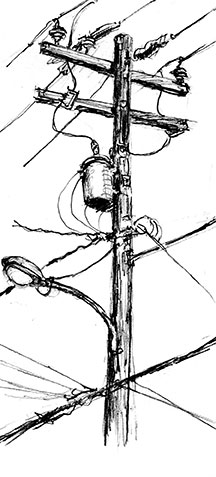Spotlight on Streetlight Conversion
Our March Third Thursday program on LED streetlight conversion in Altadena engaged more than 60 people for an eye-opening evening. Experts on night lighting, Dr. Travis Longcore, professor at the UCLA Institute of the Environment & Sustainability, and James Benya, with extensive experience designing urban street lighting, spoke and gave a Q&A that went overtime. If you missed it, visit altadenaheritage.org and you will see (from space!) how lighting conversion is affecting night skies, and much more.
Altadena Heritage’s involvement began two years ago, when we published an infrastructure-themed newsletter that included an article on LA County’s planned LED streetlight conversion. This is happening all over the country and world to save energy and maintenance costs — but hasn’t gone well everywhere. We have since dived in, learned a lot, and put our imminent conversion on the front burner of education/advocacy efforts because it will be with us for generations.
First, a tour of Altadena’s nightscape revealed its variety and randomness — from no light at all in some streets, to the familiar yellow glow of high pressure sodium lamps hanging high on power poles, to lighting districts in neighborhoods with handsome light poles closer to the ground. These latter put light where we need it, on streets and sidewalks. It is anti-intuitive, but more light does not translate to more safety or better visibility.
County Public Works assures us the new LEDs (Light Emitting Diodes) would be “dark sky compliant,” but what does that mean? This is a massive, multi-million dollar project the County, partnering with Edison, will take years to complete — with no plans for public review offered. Few of us have any idea of the consequences.
But over a year ago, we were given an idea when several intersections were converted to LEDs in an initial rollout in Altadena. People immediately started noticing the new eyeball-piercing blue glare, which triggers a whole physiological reaction (glare doesn’t “stay” in our eyes.) One example is at Allan and New York, where nine light poles replaced three. Nancy Whalen started a group called Softlight Altadena, and contacted Heritage about starting a conversation with LA County to initiate a much-needed lighting plan for Altadena. We’ve worked successfully with our Supervisor’s office on a number of projects over the years, and agreed to team up.
Our coalition has grown to 10 local groups (listed below), and led us to a wealth of research and science on how LED conversions impact safety, human health, wildlife, night skies, and historic ambiance. We learned that done well, the goals of saving money and safely lighting streets are achievable. But over the past decade, many cities made mistakes converting to LEDs, leading to unhappy citizens and expensive re-dos and retrofits, probably because the technology has evolved so quickly. Standards keep shifting as a body of evidence grows of negative health and safety impacts of high Kelvin, blue-rich diodes. (Kelvin is a measure of “color temperature,” with higher numbers tending toward blue and lower toward yellow.) We humans learn from experience, but the combination of rapid technological change and the slower pace of civic bureaucracy, contracts, and supply chains, hasn’t generally been a recipe for success in LED conversions. There are, however, several positive examples we want to learn from!
Our goal is to get the best possible conversion for our community —let Altadena be a County model for doing it right. We need a comprehensive plan before the conversion goes forward, instead of reacting to what we don’t like, as we did at those intersections. A plan is necessary because it allows us to measure things and pose questions we have now become educated enough to ask: How much energy is being saved? What will the new number of lamps be, compared to what we have now? What illumination will be achieved? Must all lights be 40 feet above the street hanging on already-overburdened poles? Will all lights be uniform, or will a zoned/timed approach be taken, according to commercial or residential use? Based on what we have learned so far, we are asking for LEDs to be diffused and amber-coated, with a eye-friendly kelvin rating of 2200-2700 for optimum visibility and safety.
We appreciate very much that Supervisor Kathryn Barger responded to our queries last year by directing that County Public Works and Southern California Edison “pause” Altadena’s conversion until we have a plan addressing public input and answers to our questions. Thank you, Supervisor, for having Public Works change out the blinding 4000 Kelvin, undiffused lamps on Allen and New York!
We want to acknowledge all the groups who joined us, or wrote letters to Supervisor Barger, supporting a plan to preserve health and safety along with our historic ambiance; Altadena came together so beautifully on this! Besides our organization and Softlight Altadena, groups include The Altadena Town Council (and its Safe Streets Committee), Neighbors Building a Better Altadena, Altadena Rotary, Altadena Chamber of Commerce, Altadena Crest Trail Restoration Working Group, Altadena Arts Coalition, LA Bat Rescue (its President lives in Altadena!), Altadena Arts Coalition, and the Arroyo Seco Foundation.

